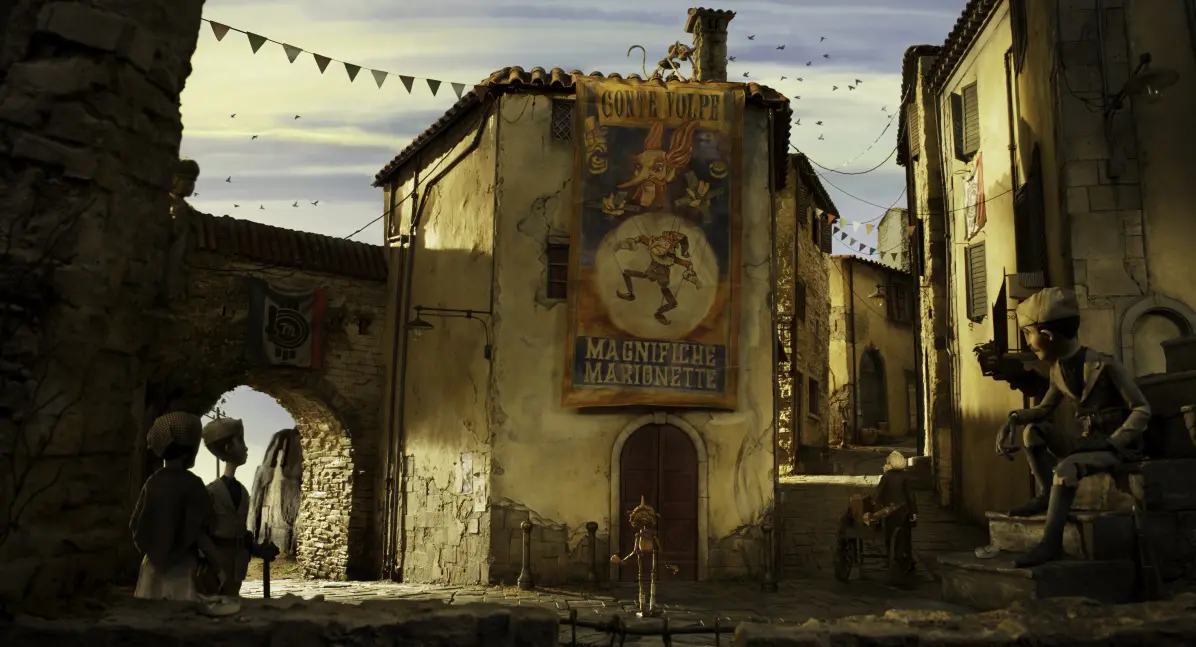

Oscar-winning director Guillermo del Toro and animation veteran Mark Gustafson bring a stop-motion version of Carlo Collodi’s iconic fable to the screen, reproducing the dark tones and existential themes of the original story.
This version of Pinocchio is set in Italy in the early 1900s. Geppetto lives in a small mountain village, presumably in Northern Italy, during Mussolini’s’ rise to power. The construction of the cobbled alleys, stone house and country lanes seems to suggest a typical mountain village in Italy. Significant research and creativity created the church, decorated with frescoes and multicoloured glass windows, with a finely sculpted crucifix above the altar.
Before long, Fascist slogans appear on the walls: believe, obey, fight. In a world where everyone is required to obey like puppets, del Toro shows us how the real puppet, Pinocchio, is the only one to disobey and rebel as he tries to find his place in the world.
Rather than going to school, Pinocchio, taken in by count Fox, prefers to perform in his travelling funfair, set amidst the ruins of a Roman amphitheatre just outside the village. Count Fox’s tour will take him to various cities: Alessandria, Livorno, Viterbo, Avellino and last Catania. Here Benito Mussolini watches a performance on the shore, his figure histrionically derided by the puppet.
Consequently, given his rebellious spirit, Pinocchio is imprisoned in a Fascist training camp, a large M-shaped fortress; it was inspired by photos of Mussolini’s real training camps.
Oscar-winning director Guillermo del Toro and animation veteran Mark Gustafson bring a stop-motion version of Carlo Collodi’s iconic fable to the screen, reproducing the dark tones and existential themes of the original story.
This version of Pinocchio is set in Italy in the early 1900s. Geppetto lives in a small mountain village, presumably in Northern Italy, during Mussolini’s’ rise to power. The construction of the cobbled alleys, stone house and country lanes seems to suggest a typical mountain village in Italy. Significant research and creativity created the church, decorated with frescoes and multicoloured glass windows, with a finely sculpted crucifix above the altar.
Before long, Fascist slogans appear on the walls: believe, obey, fight. In a world where everyone is required to obey like puppets, del Toro shows us how the real puppet, Pinocchio, is the only one to disobey and rebel as he tries to find his place in the world.
Rather than going to school, Pinocchio, taken in by count Fox, prefers to perform in his travelling funfair, set amidst the ruins of a Roman amphitheatre just outside the village. Count Fox’s tour will take him to various cities: Alessandria, Livorno, Viterbo, Avellino and last Catania. Here Benito Mussolini watches a performance on the shore, his figure histrionically derided by the puppet.
Consequently, given his rebellious spirit, Pinocchio is imprisoned in a Fascist training camp, a large M-shaped fortress; it was inspired by photos of Mussolini’s real training camps.
